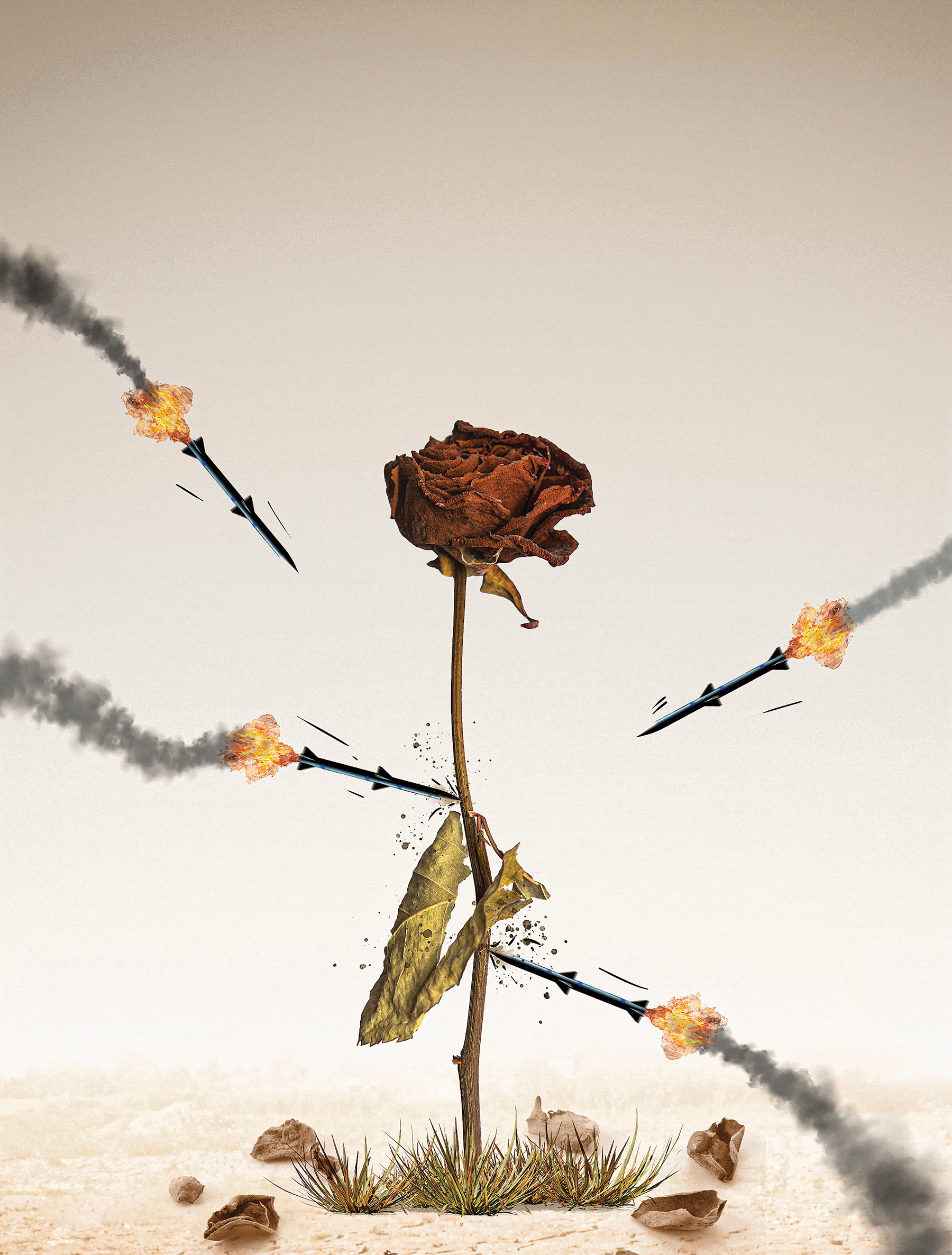What Comes Next for Gaza?
By Monia Mazigh
May/Jun 2024

Since the Israeli military’s violent assault upon Gaza, the world has watched in complete horror, feeling powerless and despair at the complete destruction of what was home to 2.2 million Palestinians. We are wondering about the meaning of public opinion in liberal democracies, where a majority has been calling for a ceasefire while many politicians oppose it. We remain struck by the double standards vis-à-vis human rights — a principle that justified the U.S. NATO, and Western military interventions in Bosnia, Iraq, Libya and elsewhere and today is being totally dismissed in the case of Israel.
After about six months of continuous bombing, often compared by historians to the carpet bombing of German cities during World War II, along with the deliberate targeting of hospitals, schools, and UNRWA refugee centers, what is left of Gaza is complete devastation. Aljazeera (Dec. 23, 2023) estimated that 60% to 70% of all residential buildings have been destroyed. From the satellite images, the very densely populated Gaza of today looks like the surface of the moon, desolate pictures of what used to be tall, crowded buildings flattened into craters, large holes, and rubble all around.
Meanwhile, Israel persists in repeating that this is all Hamas’ fault. According to this distorted logic, killing civilians is legitimate or justified either under the debunked assertion that Hamas is using civilian targets to hide its “militants” and launch its attacks, or by the “fact” that all Gazans implicitly support Hamas and thus deserve to be targeted.
This supposed logic isn’t new. Although the post-9/11 global “war on terrorism” (GWOT), has never officially ended, the U.S. considered civilians killed in drone attacks launched by it or its allies as “militants” because they were near the intended target.
After 9/11, the U.S. launched its GWOT on Afghanistan, Pakistan, Iraq and later on in Yemen and sub-Saharan Muslim countries. Despite the subsequent death of hundreds of thousands of civilians, many Muslim governments cooperated directly or indirectly with the American forces, offering military bases on their lands, having their intelligence officers collaborate with Western countries to arrest their own nationals at home and abroad, and then rendering them to black sites, torturing them to extract information, and keeping them indefinitely in dungeons or quietly executing them.
Many of these countries passed harsh anti-terrorism legislation that was sold to the populations as “protecting and defending national security.” But this same anti-terrorism legislation was instrumental in harassing and arresting opposition politicians, dissidents, or journalists.
With the ongoing genocide in Gaza, Muslim-majority countries have been pretending to be trying to stop it. But they are frozen in stillness. Worse, countries like Egypt, Jordan, the UAE, and Saudi Arabia have been directly and indirectly cooperating with Israeli intelligence to prevent international aid from entering Gaza and to attack Yemen, which has launched rockets and drones against merchant and naval vessels in the Red Sea to get Israel to stop the genocide.
Meanwhile, many of the world’s governments, watching the genocide unfold, have undertaken no serious initiatives to secure an immediate ceasefire or restore the international aid abruptly cut by several Western countries after Israel alleged that some UNRWA workers had participated in the attack.
A strong parallel exists between the aftermath of 9/11 and the Hamas attack. Both events were used as excuses to start violent wars against civilian populations. The extent of civilian casualties surpasses by far the initial reasons used to justify the counter offensives. The length of the military operations is linked to goals that cannot be achieved: the end of global terrorism (in the case of 9/11) and the toppling of Gaza’s military resistance (in the case of the October 7).
But most interesting is the reactions of the region’s Arab Muslim countries to these wars and how their autocratic regimes played with them to their own political and populist advantages.
At the beginning of the assault on Gaza, Turkey, Morocco, Algeria, Jordan, Egypt and many others allowed public protests to show solidarity. The regimes likely not only tolerated or even encouraged these events to dissipate the popular anger, but also to give the impression that both of them were aligned to stop the war. Nevertheless, as the months passed and the Israeli forces massacred roughly 45,000 Gazans, these marches almost disappeared — except in Yemen, where massive protests have been organized weekly — and the Gazans’ fate was left to Gazans.
Post-Arab Spring
Naturally, any post-Arab Spring protest in the Middle East and North Africa (MENA), is heavily monitored and authorized by the authorities.
Even in countries like Syria, where the regime has been hiding under empty slogans like “the resistance” and “the liberation of Palestine,” its fellow regimes have been shamelessly silent and inactive.
The freedoms of expression and of assembly that briefly characterized the aftermath of the Arab Spring in places like Tunisia and Egypt were replaced by populist reactions controlled by the regimes or official governmental reactions that falsely portrayed the regime as the sole and only liberator or the heroic champions of the Palestinian struggle. Behind the scenes, however, they are either silently supporting the war or directly helping the Israeli regime to eliminate Hamas.
In its origins, Hamas is either affiliated with or inspired by the Muslim Brotherhood. Many of the region’s Muslim regimes have been combatting its ideology for decades. After the Arab Spring’s initial relative success during its first years, particularly in Tunisia and Egypt, most of the Gulf royals were extremely bothered by the political changes and nervous about the future of their thrones.
Countries like the UAE and Saudi Arabia went a step further. They funded the counterrevolutionary forces, in the media and through various political parties, in those countries where the Arab Spring had brought Islamically oriented parties to power through elections. Such countries played a major role in the Arab Spring’s failure and the return of autocratic regimes in the region.
Today, the MENA countries can be roughly divided into three categories: those who had a democratic experience and failed (Tunisia and Egypt), those who did nothing to change and fiercely protected the status quo (Morocco and most of the Gulf countries, except Bahrain) and those who tried to change their regimes but failed and swirled down into war (Yemen, Libya, and Syria). In Algeria there were some attempts to change the regime; however, the military establishment was very “successful” in changing the president without changing the regime.
Overall, these Arab/Muslim populations are either tired and scared of political change or simply continuing to live under heavy state control of their livelihoods. Any form of protest and solidarity with Gaza are being considered potential threats because the organized people might turn against their respective current regime.
The Arab/Muslim populations’ current apathy is a direct result of the Arab Spring’s failure. The major reason for their political inaction is the crushing of any form of dissent in the past years and the imprisonment of many political figures, both of which have contributed to the disappearance of any sustainable, serious and effective form of solidarity.
The boycott of some American and Israeli brands that seem to be popular in countries like Egypt and Jordan merely emphasize individual actions and don’t focus on governmental or economic policies like disinvestment or reexamining the existing economic treaties that favor Israel, American or European interests.
Once again, the peoples are encouraged to adopt these “feel good” initiatives that don’t pressure countries (e.g., Turkey, Morocco, Jordan, and Egypt) to cut their diplomatic ties with Israel or threaten to support their security cooperation with the U.S. (e.g., Saudi Arabia, Qatar and the UAE).
Regardless of the war’s outcome, the Arab/Muslim countries in the MENA region will remain MIAs — missing in action — because they’re being led by incompetent and autocratic regimes who keep them “obedient” via soaring prices of food and other necessities, the lack of jobs, and a state-based media that keeps pretending that their rulers are true champions of the Palestinian cause.
Monia Mazigh, PhD, an academic, author, and human rights activist, is an adjunct professor at Carleton University (Ontario). She has published “Hope and Despair: My Struggle to Free My Husband, Maher Arar” (2008) and three novels, “Mirrors and Mirages” (2015), “Hope Has Two Daughters” (2017) and “Farida” (2020), which won the 2021 Ottawa Book Award prize for French-language fiction. She has also published an essay/memoir “Gendered Islamophobia: “My Journey with a Scar(f)” (2023), which was nominated for the Governor General Literary Non-fiction Award.
Tell us what you thought by joining our Facebook community. You can also send comments and story pitches to horizons@isna.net. Islamic Horizons does not publish unsolicited material.
